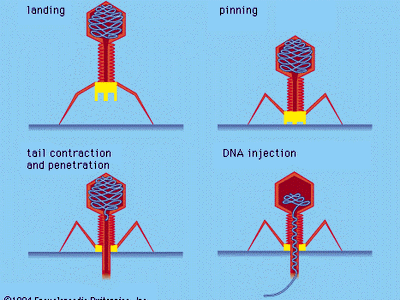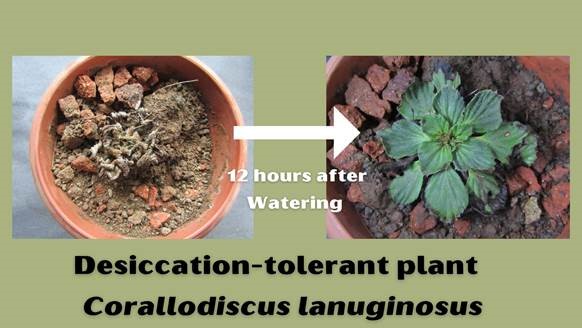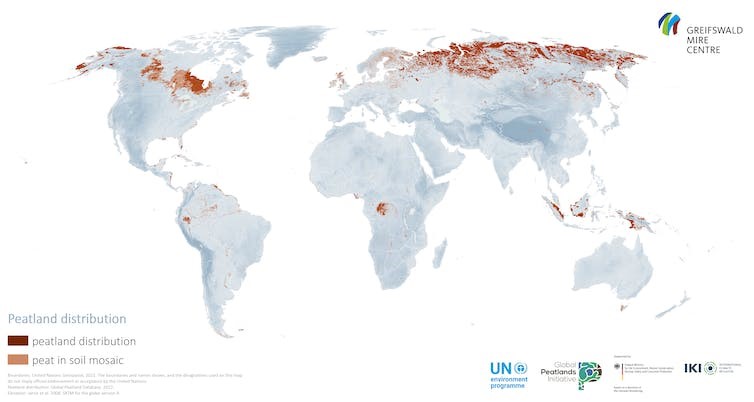Bacteriophages
Outbreaks of viral diseases have killed billions but not all viruses are killers, some bacteria and viruses are good and also be beneficial for health.
- Bacteriophage, also called phage or bacterial virus, any of a group of viruses that infect bacteria.
- Discovered by - Bacteriophages were discovered independently by Frederick W. Twort in Great Britain (1915) and Felix d’Herelle in France (1917).
- D’Herelle coined the term bacteriophage, meaning “bacteria eater,” to describe its bacteriocidal ability.
- Characteristics - Bacteriophages also infect the single-celled prokaryotic organisms known as archaea.
- Thousands of varieties of phages exist, each of which may infect only one type or a few types of bacteria or archaea.
- Phages are classified in a number of virus families namely Inoviridae, Microviridae, Rudiviridae, and Tectiviridae.
- Like all viruses, phages are simple organisms that consist of a core of genetic material (nucleic acid) surrounded by a protein capsid.
- The nucleic acid may be either DNA or RNA and may be double-stranded or single-stranded.
- There are 3 basic structural forms of phage - an icosahedral (20-sided) head with a tail, an icosahedral head without a tail, and a filamentous form.

- Process in human body - Bacteriophages are harmless to human cells as they do not recognize them as their bacterial prey.
- The vast majority of viruses inside human body are bacteriophages (viruses that kill bacteria in the human body’s microbiomes).
- They work by hunting down bacteria and attaching themselves to the surface of a bacterial cell, before injecting viral DNA material into the cell.
- The viral DNA then replicates inside the bacteria, sometimes by borrowing the DNA replication hardware of the bacteria.
- Once enough new viruses have been created inside the bacterial cell, the cell then bursts to release the new viral particles.
- All this takes just 30 minutes, meaning one virus can become many in a couple of hours.
- Phage therapy - Twort and d’Hérelle began to use phages in treating human bacterial diseases such as bubonic plague and cholera.
- Phage therapy was not successful, and after the discovery of antibiotics in the 1940s, it was virtually abandoned.
References
1. The Indian Express | what are Bacteriophages?
2. Britannica | bacteriophage
Desiccation-tolerant (DT) vascular plants
In the Western Ghats, researchers have found 62 species of plants, 16 are Indian endemic, and 12 are exclusive to Western Ghat outcrops that can survive extreme dehydration.
- Hydration and desiccation-tolerance are two commonly studied strategies for plants in extreme habitats.
- Hydration is a condition where plant tissues can tolerate more than 30% of water content.
- But in desiccation, plants undergo longer dry days during which the moisture content of the leaves is the same as in the air.
- Desiccation-tolerant (DT) vascular plants are able to withstand extreme dehydration, losing up to 95% of their water content, and they revive themselves once water is available again.
- Characteristics - DT plant varieties are found in both flowering and non-flowering species and in both temperate and tropical climates.
- They are usually found in rocky outcrops and can recover quickly when water supplies are restored.
- Ferricretes (layers of sedimentary rock) and basaltic plateaus seemed to be the preferred habitats.
- Some species were found to survive at increasing temperatures, which is crucial for the warming planet.
Some plant species ranging from algae to angiosperms thrive in harsh environments and are termed as extremophytes.
- DT in India - India now has 9 new generic records for the global list of desiccation-tolerant (DT) vascular plants.
- They are identified as Pyrrosia, Aleuritopteris, Corallodiscus, Arundinella, Bhidea, Bothriochloa, Danthonidium, Dimeria and Glyphochloa.
- Colour changes and morphological characteristics were also observed in the species to adapt to the dryness.
|
Species
|
Changes
|
|
Tripogon
|
It changes it colours from greyish in dry conditions to green in hydrated situations.
|
|
Oropetium Thomaeum
|
Changes colour from green in hydrated phase to dark purple or orange
From greyish to ash colour during the period of desiccation.
|
|
Ferns (fronds)
|
Curling inwards towards the costa, exposing spores at the start of the dry season and during brief dry spells.
|
|
C lanuginosus
|
Not directly exposing them to sunlight during the desiccation phase.
|

References
1. Down to Earth | Plants that can survive extreme dehydration
2. PIB | Desiccation-tolerant vascular (DT) plants
Dark stars
Recently, Webb telescope captures tantalizing evidence for three mysterious ‘dark stars’.
- Dark stars are immense, ultrabright hypothetical objects that are powered by dark matter rather than nuclear fusion.
Dark matter is an invisible material whose presence is known mainly based on its gravitational effects at a galactic scale.
- Dark matter is invisible to us it does not produce or directly interact with light.
- As per the findings of Webb telescope, Dark stars are described as made almost entirely of hydrogen and helium with 0.1% of their mass in the form of dark matter.
- Mass - Dark stars would be able to achieve a mass at least a million times greater than the sun and a luminosity at least a billion times greater.
- Diameter - Roughly 10 times the distance between Earth and the sun.
- Dark stars are cooler than ordinary stars.
- Unlike ordinary stars, they would be able to gain mass by accumulating gas falling into them in space…
- They can continue to accrete the surrounding gas almost indefinitely, reaching supermassive status as long as there was enough dark matter to fuel them
- Dark stars are so massive that they end their lives as a black hole.
- It was the nuclear fusion occurring in the cores of those stars that spawned elements heavier than hydrogen and helium.
- As per recent findings, The three objects pegged as potential dark stars date to early in the universe’s history -
- One from 330 million years after the Big Bang event that got the cosmos going 13.8 billion years ago, and
- The others from 370 million years and 400 million years after the Big Bang.
One supermassive dark star is as bright as an entire galaxy
James Webb telescope
- The James Webb Space Telescope is an infrared telescope formerly known as the "Next Generation Space Telescope".
- Launch - 2021.
- Aim - To study the earliest stars and peer back farther into the universe's past than ever before.
- Webb is an international collaboration between NASA, ESA (the European Space Agency), and the Canadian Space Agency (CSA).
- The Webb telescope is said to be the scientific successor to the Hubble Space Telescope.
- It is NASA’s largest and most powerful space science telescope ever constructed.

References
1. The Indian Express | Webb telescope captures dark stars
2. Live science | James Webb telescope reveals 3 possible 'dark stars
3. India Today | Webb telescope finds mysterious dark stars
Zombie fires (Arctic Soil Fires)
The blanket of wildfire smoke spread across large parts of the U.S. and Canada in 2023 due to zombie fires.
- Zombie fires happen as a result of wildfires, they're called zombie fires as they seem to come back from the dead.
- After a wildfire has been extinguished on the surface, some of it can still burn belowground in secret, fuelled by peat and methane.
- These fires can continue to burn all through winter, hidden under a layer of snow.
- In spring as the temperature rises, the snow melts and the soil dries out, the wildfires can re-ignite and spread once again.
- Soil fires that spread underground are harder for firefighters to tame and extinguish, thus demanding more resources for longer periods of time.
- Because peat fires can make the ground unstable, using heavy equipment to excavate the fire areas also becomes risky.
- Finally, these soil fires don’t die easily.
Northern ecosystems store twice as much carbon in their peat and permafrost as the atmosphere, and both are increasingly vulnerable to fire.
- Zombie fires also known as overwintering fires are a rare phenomenon that occur in countries like Canada, Alaska, and Russia.
- Recent happenings - In June and July 2019, temperatures around the world were some of the hottest on record, and more than 100 wildfires burned in the Arctic Circle.
- They emitted a record 244 megatonnes of carbon dioxide, and destroyed millions of hectares of forests across Siberia, Alaska, Greenland, and Canada.
- Reasons - The Arctic is warming nearly four times faster than the rest of the world, a phenomenon known as Arctic amplification.
- The Arctic has already exceeded a 2 °C (3.6 °F) increase compared with pre-industrial times.
- That rise in temperature brings with it a number of changes to the environment that make the forest and tundra more susceptible to burning.
- Other conditions favor for wildfires - Changes in atmospheric circulation that create periods of extreme heat, dry out vegetation and reduce moisture in soils, and lead to more frequent lightning strikes.

References
1. Down to Earth | Zombie fires in the Arctic
2. BBC | what are 'zombie fires'?
3. The Conversation | Zombie fires in the Arctic
World Drug Report 2023
The recently released UNODC report says that highest prevalence of opioid use disorders were in eastern parts of India.
- Released by - United Nations Office on Drugs and Crime’s (UNODC).
- Global Scenario - The number of people globally abusing drugs rose by 23% between 2011 and 2021.
- Among all countries that ranked the drugs leading to drug use disorders,
- The majority 46% of countries reported cannabis in first place
- 31% of countries reported opioids in first place, mainly heroin.
- Amphetamine-type stimulants, in particular methamphetamine, were reported in first place by 13% of countries.
- As per the report, the ranking in each country was determined mainly by 2 factors — prevalence of use and dependence potential.
- The report also found that the cocaine demand and supply has also risen worldwide and methamphetamine trafficking has also occurred mainly in Afghanistan.
- In India - According to the report, in 2018 alone, India had the highest prevalence of opioid use in South Asia at 2.1%.
- The report states that the opioid use in India is mainly a male phenomenon with more than 95% of all opioid users being males.
- The opioid users are among the population aged 10-75, the overall rates of opioid users range between 0.2 and 25.2%.
- The highest prevalence of people with opioid use disorders in India is observed in the eastern parts of the country.
- The largest numbers of people with opioid use disorders are found in north-western India (Uttar Pradesh, Punjab and Haryana) as well as in central-western States (Maharashtra and Madhya Pradesh).
- The high level now also found in Maharashtra appears linked to the increasing quantities of opiates being trafficked to India from Southwest Asia by sea.
United Nations Office on Drugs and Crime (UNODC)
- The United Nations Office on Drugs and Crime (UNODC) was established in 1997.
- UNODC is a global leader in the fight against illicit drugs and international crime.
- Aim - To contribute to global peace and security, human rights and development by making the world safer from drugs, crime, corruption and terrorism.
- Headquarters - Vienna.
- Objectives
- Tackling the world drug problem
- Preventing corruption
- Countering terrorism
- Combating organized crime
- Preventing crime and promoting criminal justice
- Partnerships
- UNODC cooperates with a wide range of stakeholders to maximize the impact of our work.
- These include governments, civil society organizations, academic and research institutions, the private sector, international and regional organizations and other UN entities.
References
1. The Hindu | UNODC report
2. Gaon Connection | Globally, 296 Million Illicit Drug Users in 2021
3. UNODC | About UNODC



